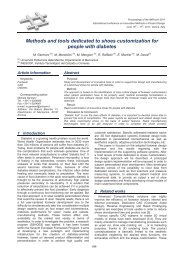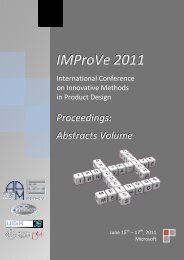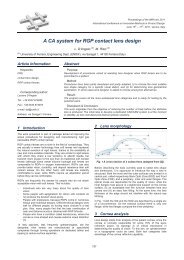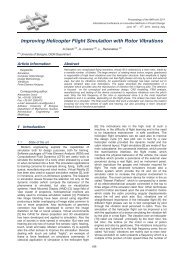IMProVe 2011 - Proceedings
IMProVe 2011 - Proceedings
IMProVe 2011 - Proceedings
Create successful ePaper yourself
Turn your PDF publications into a flip-book with our unique Google optimized e-Paper software.
Integrated Product and Process Design<br />
Shape Similarity: Methods and Industrial Applications<br />
D. Francia (a), A. Ceruti (a), G. Caligiana (a), A. Liverani (a)<br />
(a) University of Bologna<br />
Abstract:<br />
Mass production, reduced production investment, reduced response time and variability,<br />
globalization and increased customization are the most responsible for the need of<br />
optimizing the manufacturing process. As companies provide higher levels of<br />
customization, the number of products offered increases. Minimizing the cost of providing<br />
variety is possible by exploiting shape similarities amongst parts and products. Another<br />
reason for utilization of similarity assessment is the cost estimation. Total cost of any part<br />
to machine results from material costs, setup costs, tooling costs, and operation costs.<br />
Furthermore in very small productions the total cost of new components is affected more<br />
than 70% by process planning and CAM (Computer Aided Manufacturing) programming. A<br />
relevant part of this time may be saved by modifying the process plan of an old similar<br />
part and this is a well known practice in the manufacturing industry.<br />
Shape similarity search in a CAD system is an answer to reduce process plan preparation<br />
because it finds similarities in geometry by extracting shape signatures from the 3D<br />
models and then comparing these signatures exploiting distance functions. This paper<br />
presents a review of the methods adopted to generate shape signatures and an analysis of<br />
the distance functions suitable for the comparison. The first part of this work investigates<br />
the models commonly proposed to extract the shape signature from a solid part. The<br />
second part of the paper discusses the choice of the distance function. At the end of this<br />
discussion the most appropriate method is proposed to assess the shape similarity, once<br />
the part to be manufactured has been assigned: results are shown in terms of accuracy of<br />
comparison and computational time, seeking for a trade-off between them.<br />
Keywords: Shape Similarity, Computer Aided Design, Computer Aided Manufacturing,<br />
Standardization<br />
Corresponding Author: Daniela Francia<br />
Tel.: +39.051.2093352<br />
Fax.: +39.051.2093412<br />
e-mail: d.francia@unibo.it<br />
Address: v.le Risorgimento, 2, 40137 Bologna.<br />
June 15 th – 17 th , <strong>2011</strong>, Venice, Italy<br />
56<br />
<strong>IMProVe</strong> <strong>2011</strong> - <strong>Proceedings</strong>










